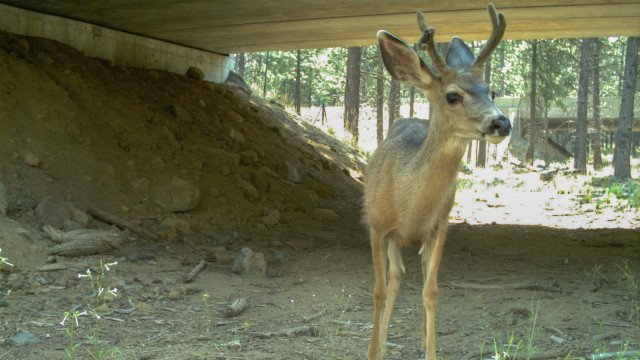Watch for wildlife: Oregon wildfires have shifted some migration routes

Underpasses have helped, but state still sees 1,000s of collisions each year
PORTLAND, Ore. (KTVZ) -- Like many animals, deer and elk are on the move this time of year, migrating to their winter range and attempting to navigate through a maze of human development, including roadways.
In 2019, the Oregon Department of Transportation reported 6,102 wildlife-vehicle collisions, with 2,307 of those occurring between October and December. Researchers believe the actual number of wildlife-vehicle collisions is at least twice that number, with over 12,000 statewide each year, according to the Oregon Wildlife Federation.
This fall and into winter, as wildfires have demolished habitats and reorganized animal communities, animals are moving in unorthodox ways, and Oregon wildlife and transportation experts recommend drivers be even more cautious on Oregon's highways and roads.
An effective solution
Installation of structures that funnel animals safely over and under roads is a viable solution for reducing wildlife-vehicle collisions. Unfortunately, while other states have constructed dozens of passage projects, only a handful have been built in Oregon.
Below are results that illustrate how effective these passages are in protecting the safety of both wildlife and humans:
- An underpass on Highway 97 near Lava Butte decreased mule deer-vehicle collisions by 87% after its completion in 2012.
- Pioneer Mountain Eddyville Wildlife Underpass on highway 20 in the Coast Range has dramatically reduced vehicle collisions with elk and blacktail deer in an area where that was a frequent occurrence.
- Boeckman Road underpass project in Wilsonville has provided thousands of safe passage events for resident wildlife, including deer, red-legged frogs, mink, and salamanders since its construction in 2008.
While these structures provide a great benefit, there is an urgent need for more throughout the state. Mule deer populations are in decline, over 40 percent in some areas, with no reliable funding available for passage projects.
"Watch for Wildlife" and reduce collisions
Fortunately, the community can help reduce the negative impact that vehicles have on wildlife populations by purchasing the Oregon Wildlife Foundation's "Watch for Wildlife" special registration license plate voucher. The plate features a mule deer and the Cascade Mountain range.
Once 3,000 vouchers are sold and the plate goes into production, proceeds will provide dedicated funding for wildlife passage projects across Oregon to benefit multiple species. Here are a few examples of those in need of support:
- Highway 97 passage near Gilchrist, which will be complete in Spring 2021, will provide migrating mule deer in central Oregon and motorist safe passage.
- In the community of Linnton near Portland, volunteers shuttle red-legged frogs from their home in Forest Park across busy highway 30 to their breeding wetlands and back again each year. This temporary solution is now in its seventh year. While several passage solutions have been proposed, they currently lack funding support.
- In southwest Oregon, blacktail deer migrating to and from their winter range in the valley are frequently involved in collisions on I-5 and surrounding roadways. Opportunities exist to retrofit large culverts to better accommodate wildlife movement, including deer.
With more people moving to Oregon every year, development will only continue to fragment wildlife habitat and migration corridors, and subsequently, the rate of human-wildlife interactions and collisions.
In addition to supporting the "Watch for Wildlife" campaign, motorists can protect wildlife, other people, and themselves this fall and holiday season by taking extra precautions such as:
- scanning the road as you drive,
- slightly lowering your dashboard lights,
- obeying the speed limit, particularly in hotspots such as Highway 97 in Central Oregon, Highway 42 east of Roseburg and Highway 101 between Seaside and Astoria.